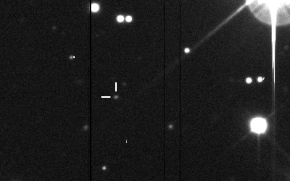 Megaclite imaged by the Canada-France-Hawaii Telescope in December 2001 | |
| Discovery [1] | |
|---|---|
| Discovered by | Scott S. Sheppard David C. Jewitt Yanga R. Fernandez Eugene A. Magnier |
| Discovery site | Mauna Kea Observatory |
| Discovery date | 25 November 2000 |
| Designations | |
Designation | Jupiter XIX |
| Pronunciation | /mɛɡəˈklaɪtiː/ |
Named after | Μεγακλειτή Megaclītē |
| S/2000 J 8 | |
| Adjectives | Megaclitean /ˌmɛɡəklɪˈtiːən/ |
| Orbital characteristics [2] | |
| Epoch 27 April 2019 (JD 2458600.5) | |
| Observation arc | 16.26 yr (5,938 days) |
| 0.1586666 AU (23,736,190 km) | |
| Eccentricity | 0.4102170 |
| –747.09 d | |
| 269.64681° | |
| 0° 28m 54.732s / day | |
| Inclination | 143.20224° (to ecliptic) |
| 356.52408° | |
| 8.71854° | |
| Satellite of | Jupiter |
| Group | Pasiphae group |
| Physical characteristics[3] | |
| ≈ 6 km | |
| Albedo | 0.04 (assumed) |
| 21.7[4] | |
| 15.0[2] | |
Megaclite /mɛɡəˈklaɪtiː/, also known as Jupiter XIX, is a natural satellite of Jupiter. It was discovered by a team of astronomers from the University of Hawaii led by Scott S. Sheppard in 2000, and given the temporary designation S/2000 J 8.[5][1][6]
Megaclite is about 6 kilometres in diameter, and orbits Jupiter at an average distance of 24,687,000 kilometers in 747.09 days, at an inclination of 150° to the ecliptic (148° to Jupiter's equator), in a retrograde direction and with an eccentricity of 0.308.
It was named in October 2002 after Megaclite, mother by Zeus (Jupiter) of Thebe and Locrus in Greek mythology. It was initially erroneously named Magaclite, which was corrected in November 2002.[7][8] Despite this correction, some earlier research still referred to the moon as Magaclite.[9]
It belongs to the Pasiphae group, irregular retrograde moons orbiting Jupiter at distances ranging between 22.8 and 24.7 Gm, and with inclinations ranging between 144.5° and 158.3°. However, while Pasiphae belongs to the grey color class (V=17.22 B−V=0.74, V−R=0.38), Megaclite falls under the light red color class (V=22.07 B−V=0.94, V−R=0.41), similarly to Callirrhoe and Sinope.[9]
References
- ^ a b MPEC 2001-A29: S/2000 J 7, S/2000 J 8, S/2000 J 9, S/2000 J 10, S/2000 J 11 2001 January 15 (discovery and ephemeris)
- ^ a b "M.P.C. 115890" (PDF). Minor Planet Circular. Minor Planet Center. 27 August 2019.
- ^ "Planetary Satellite Physical Parameters". Jet Propulsion Laboratory. 19 February 2015. Retrieved 26 November 2020.
- ^ Sheppard, Scott. "Scott S. Sheppard - Jupiter Moons". Department of Terrestrial Magnetism. Carnegie Institution for Science. Retrieved 26 November 2020.
- ^ IAUC 7555: Satellites of Jupiter Archived 2002-09-16 at the Wayback Machine 2001 January 5 (discovery)
- ^ MPEC 2001-T59: S/2000 J 8, S/2000 J 9, S/2000 J 10 2001 October 15 (revised ephemeris)
- ^ IAUC 7998: Satellites of Jupiter 2002 October 22 (naming the moon "Magaclite")
- ^ IAUC 8023: Satellites of Jupiter 2002 November 29 (correcting the name)
- ^ a b Grav, Tommy; Holman, M. J.; Gladman, B. J.; Aksnes, K. (2003). "Photometric survey of the irregular satellites". Icarus. 166 (1): 33–45. arXiv:astro-ph/0301016. Bibcode:2003Icar..166...33G. doi:10.1016/j.icarus.2003.07.005. S2CID 7793999.










